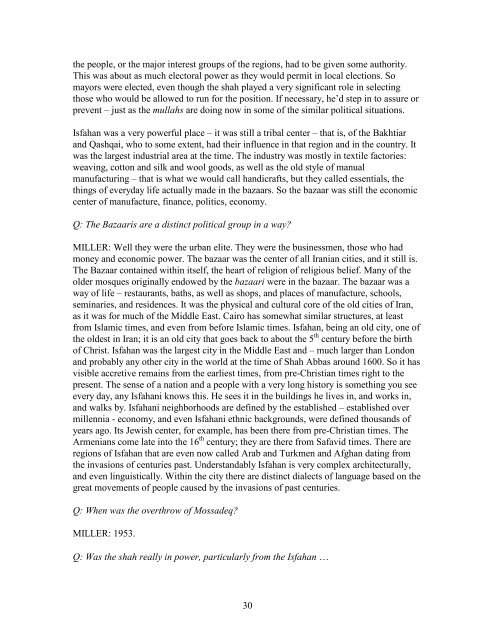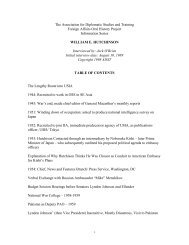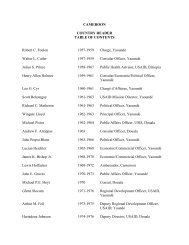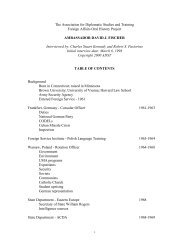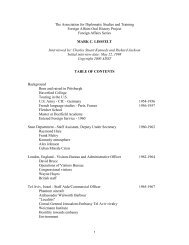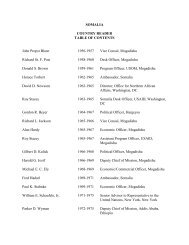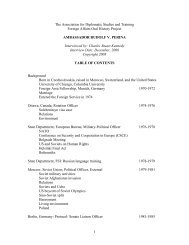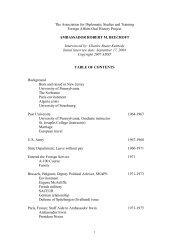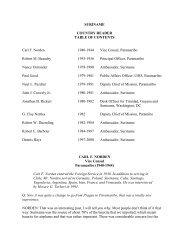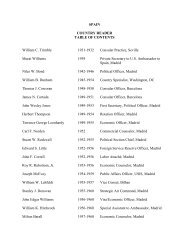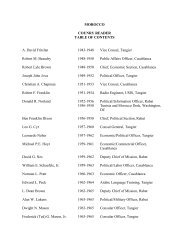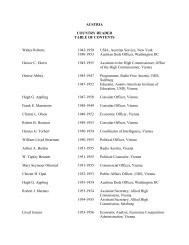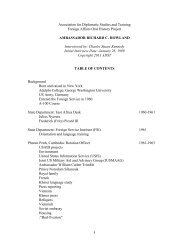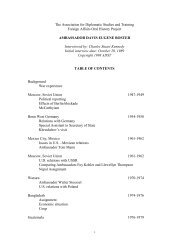1 The Association for Diplomatic Studies and Training Foreign ...
1 The Association for Diplomatic Studies and Training Foreign ...
1 The Association for Diplomatic Studies and Training Foreign ...
Create successful ePaper yourself
Turn your PDF publications into a flip-book with our unique Google optimized e-Paper software.
the people, or the major interest groups of the regions, had to be given some authority.<br />
This was about as much electoral power as they would permit in local elections. So<br />
mayors were elected, even though the shah played a very significant role in selecting<br />
those who would be allowed to run <strong>for</strong> the position. If necessary, he’d step in to assure or<br />
prevent – just as the mullahs are doing now in some of the similar political situations.<br />
Isfahan was a very powerful place – it was still a tribal center – that is, of the Bakhtiar<br />
<strong>and</strong> Qashqai, who to some extent, had their influence in that region <strong>and</strong> in the country. It<br />
was the largest industrial area at the time. <strong>The</strong> industry was mostly in textile factories:<br />
weaving, cotton <strong>and</strong> silk <strong>and</strong> wool goods, as well as the old style of manual<br />
manufacturing – that is what we would call h<strong>and</strong>icrafts, but they called essentials, the<br />
things of everyday life actually made in the bazaars. So the bazaar was still the economic<br />
center of manufacture, finance, politics, economy.<br />
Q: <strong>The</strong> Bazaaris are a distinct political group in a way?<br />
MILLER: Well they were the urban elite. <strong>The</strong>y were the businessmen, those who had<br />
money <strong>and</strong> economic power. <strong>The</strong> bazaar was the center of all Iranian cities, <strong>and</strong> it still is.<br />
<strong>The</strong> Bazaar contained within itself, the heart of religion of religious belief. Many of the<br />
older mosques originally endowed by the bazaari were in the bazaar. <strong>The</strong> bazaar was a<br />
way of life – restaurants, baths, as well as shops, <strong>and</strong> places of manufacture, schools,<br />
seminaries, <strong>and</strong> residences. It was the physical <strong>and</strong> cultural core of the old cities of Iran,<br />
as it was <strong>for</strong> much of the Middle East. Cairo has somewhat similar structures, at least<br />
from Islamic times, <strong>and</strong> even from be<strong>for</strong>e Islamic times. Isfahan, being an old city, one of<br />
the oldest in Iran; it is an old city that goes back to about the 5 th century be<strong>for</strong>e the birth<br />
of Christ. Isfahan was the largest city in the Middle East <strong>and</strong> – much larger than London<br />
<strong>and</strong> probably any other city in the world at the time of Shah Abbas around 1600. So it has<br />
visible accretive remains from the earliest times, from pre-Christian times right to the<br />
present. <strong>The</strong> sense of a nation <strong>and</strong> a people with a very long history is something you see<br />
every day, any Isfahani knows this. He sees it in the buildings he lives in, <strong>and</strong> works in,<br />
<strong>and</strong> walks by. Isfahani neighborhoods are defined by the established – established over<br />
millennia - economy, <strong>and</strong> even Isfahani ethnic backgrounds, were defined thous<strong>and</strong>s of<br />
years ago. Its Jewish center, <strong>for</strong> example, has been there from pre-Christian times. <strong>The</strong><br />
Armenians come late into the 16 th century; they are there from Safavid times. <strong>The</strong>re are<br />
regions of Isfahan that are even now called Arab <strong>and</strong> Turkmen <strong>and</strong> Afghan dating from<br />
the invasions of centuries past. Underst<strong>and</strong>ably Isfahan is very complex architecturally,<br />
<strong>and</strong> even linguistically. Within the city there are distinct dialects of language based on the<br />
great movements of people caused by the invasions of past centuries.<br />
Q: When was the overthrow of Mossadeq?<br />
MILLER: 1953.<br />
Q: Was the shah really in power, particularly from the Isfahan …<br />
30


